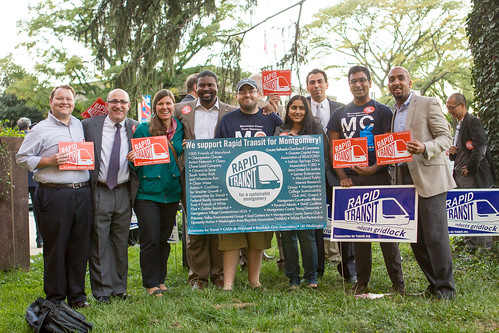Last night, a coalition of 32 civic, business, activist and environmental organizations announced their support for Montgomery County's proposed Bus Rapid Transit network at the first of two public hearings on the issue at the County Council in Rockville.
After 5 years of study, this fall the Council will consider a plan to build an 82-mile rapid transit network on several major roads, including Rockville Pike, Georgia Avenue, Veirs Mill Road, and Columbia Pike. Planners say that BRT will allow us to move more people on existing roads as the county grows from 1 million residents today to 1.2 million in 2040.
David Moon of advocacy group Communities for Transit and the Coalition for Smarter Growth unveiled their list of "strange bedfellows" who support the plan, ranging from the Sierra Club to ULI Washington and CASA de Maryland. Before the hearing, they held a press conference to call for a BRT network that has dedicated lanes, frequent and reliable service, bike and pedestrian improvements along transit corridors, and "Metro-like features," which include widely spaced stops, stations with safe, comfortable waiting areas, and fare collection at the station.

The Montgomery County Young Democrats have also lent their support. "We hosted a forum this summer about what young people need in order to settle down in Montgomery County," said Katie Mullen, a Young Dems member who lives in Burtonsville. "Of the almost 100 people in attendance, the #1 priority wasn't more night life, affordable housing, or new industry. The #1 priority was to greatly expand public transit across the county, in particular a comprehensive Bus Rapid Transit network with dedicated lanes."
Opponents of the BRT plan who spoke at the meeting came primarily from two neighborhoods: Chevy Chase West, which is adjacent to a proposed route along Wisconsin Avenue, and the Four Corners area of Silver Spring, near proposed routes along Route 29 and University Boulevard. They cited concerns about the cost of building BRT, the inconvenience to drivers if the county repurposes existing lanes for buses, and claimed that public hadn't gotten enough opportunities to give feedback.
Councilmember Marc Elrich, who first proposed a BRT network, contested claims that the county was preparing to condemn 3,000 properties for a system that hasn't been fully designed, or that it was a "sellout" to real estate developers.
"I'm probably the last person on earth, or at least in this room, that would do something on behalf of developers," he said. "It happens that [development] serves the rest of county residents in the ability to grow our tax base and deal with county traffic. There is no way to not see the development that is coming in the plans."
I live-tweeted the hearing along with Kelly Blynn from the Coalition for Smarter Growth and Ted Van Houten from the Action Committee for Transit. Here's a Storify of the night's highlights:
 | ||
| Transit supporters wave signs at last night's hearing. Photo by betterDCregion on Flickr. |
After 5 years of study, this fall the Council will consider a plan to build an 82-mile rapid transit network on several major roads, including Rockville Pike, Georgia Avenue, Veirs Mill Road, and Columbia Pike. Planners say that BRT will allow us to move more people on existing roads as the county grows from 1 million residents today to 1.2 million in 2040.
David Moon of advocacy group Communities for Transit and the Coalition for Smarter Growth unveiled their list of "strange bedfellows" who support the plan, ranging from the Sierra Club to ULI Washington and CASA de Maryland. Before the hearing, they held a press conference to call for a BRT network that has dedicated lanes, frequent and reliable service, bike and pedestrian improvements along transit corridors, and "Metro-like features," which include widely spaced stops, stations with safe, comfortable waiting areas, and fare collection at the station.

The Montgomery County Young Democrats have also lent their support. "We hosted a forum this summer about what young people need in order to settle down in Montgomery County," said Katie Mullen, a Young Dems member who lives in Burtonsville. "Of the almost 100 people in attendance, the #1 priority wasn't more night life, affordable housing, or new industry. The #1 priority was to greatly expand public transit across the county, in particular a comprehensive Bus Rapid Transit network with dedicated lanes."
Opponents of the BRT plan who spoke at the meeting came primarily from two neighborhoods: Chevy Chase West, which is adjacent to a proposed route along Wisconsin Avenue, and the Four Corners area of Silver Spring, near proposed routes along Route 29 and University Boulevard. They cited concerns about the cost of building BRT, the inconvenience to drivers if the county repurposes existing lanes for buses, and claimed that public hadn't gotten enough opportunities to give feedback.
Councilmember Marc Elrich, who first proposed a BRT network, contested claims that the county was preparing to condemn 3,000 properties for a system that hasn't been fully designed, or that it was a "sellout" to real estate developers.
"I'm probably the last person on earth, or at least in this room, that would do something on behalf of developers," he said. "It happens that [development] serves the rest of county residents in the ability to grow our tax base and deal with county traffic. There is no way to not see the development that is coming in the plans."
I live-tweeted the hearing along with Kelly Blynn from the Coalition for Smarter Growth and Ted Van Houten from the Action Committee for Transit. Here's a Storify of the night's highlights:

1 comment:
I think it's foolish not to pursue BRT. I think it's foolish not to go all the way with it, rather than trying to save money by cutting arterial routes. And I think it would be absolutely heinous to "repurpose" traffic lanes for BRT. I am prepared to be called a tree-hating monster. See? I just called me that, myself.
Post a Comment